mobile View, to the German Version tap the flag

- Galicia (Galizien)
- former Austrian crown land: Kingdom of Galicia and Lodomeria with the Grand Duchy of Krakau and the Duchies of Auschwitz and Zator
- northern the Carpatia Montains, today separated between Poland and Ukraine
- Polish: 1.) Galicja 2.) Królestwa Galicji i Lodomerii
• Flag
• Meaning/Origin of the Flag
• Coat of Arms
• Meaning/Origin of the Coat of Arms
• Map of the former crown lands of Austria-Hungary (to 1918)
• Maps of Galicia
• Numbers and Facts
• History
• Origin of the Country's Name
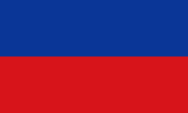
1772–1861(?),
A) Flag of the country (Colours of the country),
B) Flag of the today's Western Galicia,
ratio = 2:3,
Source, by:
Flags of the World



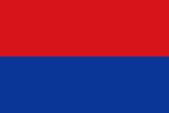
1861(?)–1918,
Flag of the country (Colours of the country),
ratio = 2:3,
Source, by:
Flags of the World



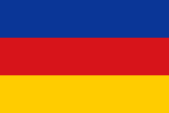
Variant,
A) Flag of the country (Colours of the country),
B) Flag of the today's Eastern Galicia
ratio = 2:3,
Source, by:
Flags of the World,
Österreichisch-Ungarische Wappenrolle



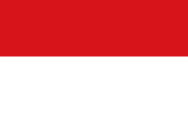
Flag of the Poles in Galicia
ratio = 2:3,
Source, by:
Österreichisch-Ungarische Wappenrolle



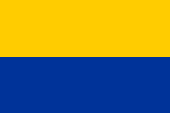
Flag of the Ruthenians (Ukrainians) in Galicia
ratio = 2:3,
Source, by:
Österreichisch-Ungarische Wappenrolle





The country had – like all the other crown lands of the Austrian crown – its own colours (Landesfarben), which were used amongst others on horizontally two- or three-striped flags. The colours (Landesfarben) were very often taken from the respective coat of arms of the country or were supplemented by another colour, which not appears in the coat of arms, or they went back to older models of the coat of arms (e.g. Carniola). Officially, the colours had never been regulated or stipulated, so that their sequence varied in practice or even the colors deviated. The Austrian heraldist Hugo Gerard Ströhl (1851–1919) was probably the first to take care of it and asked for the colors (Landesfarben) on the flags at the respective state authorities around 1890 and compiled them.
This process turned out to be very difficult for Galicia, because when Ströhl asked, very different informations were given for the colours of the country: gold-blue, red-white, blue-red, blue-red-gold and others. Fact is, that every nation which lived in the country, has used its own colours. It is understandable that each nation may have preferred its own colors as the colors of the whole country. Red and white can be explained as the colours of the Poles, and gold and blue as the colours of the Ruthenians (Ukrainians). The combination of blue and red can easily be explained as the colors of the country, because they were taken from the coat of arms of the country, which was created in 1772 as "Kingdom of Galicia and Lodomeria" as a result of the First Partition of Poland. However, the development of national colors was a process that started late, especially in landlocked countries (at the end of the 18th and beginning of the 19th century) and took a long time. The definition of states by the concept of the nation (and not only by the ruler) began in Europe with the era of Napoléon and was completed not until the national revolutions of 1830 and 1849. In this respect, blue-red could be called as the original colours of Galicia, which became current at the latest in 1849 with the new Austrian constitution and the establishment of crown lands with their own parliaments. In 1861, the Duchy of Bukovina (Buchenland) was separated from Galicia as its own crown land, which also used blue-red as the country's colors. This is probably why Galicia switched from blue-red to red-blue to avoid confusion. The three-striped colours in blue-red-gold can be explained in that: by adding of the color gold, they also show the combination blue-red, and thus they appear more "Ukrainian". That seems plausible, because exactly this combination also stands for today's Eastern Galicia, which has belonged to Ukraine since 1939.
Why Ströhl in his work "Österreichisch-Ungarische Wappenrolle" (1890, 1894 and 1900) then of all things named red and white as the country's colours remains puzzling, because these colours, also in this order, stand for the Polish nation, what he also has mentioned in "Österreichisch-Ungarische Wappenrolle". Between 1697 and 1763 the flag of the Kingdom of Poland showed red and white. The Prussian Province of Posen (until 1830 Grand Duchy of Posen, in 1793 by the Second Partition of Poland to Prussia) also showed the colors red and white between 1815 and 1886. Even in terms of the nations and its colours, only half of the population would be represented with red and white, and as you know, the Ruthenians had their own colors. In this respect, red and blue appear to be the most recently used country colors.
Source: Österreichisch-Ungarische Wappenrolle,
Flags of the World,
Volker Preuß


to 1804,
Blazon of Galicia,
Source, by: Österreichisch-Ungarische Wappenrolle

Blazon of Galicia,
Source, by: Ströhl, Große Wappenrolle

Blazon of Lodomeria,
Source, by: Ströhl, Große Wappenrolle

Blazon of Galicia and Lodomeria
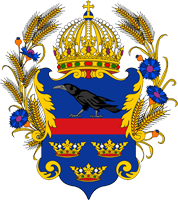
ca.1890–1918,
Coat of arms of the Kingdom of Galicia,
Source, by: Ströhl, Wappenrolle Österreich-Ungarns, 1890, via Wikipedia (D)

The coat of arms of the crown land "Kingdom of Galicia and Lodomeria with the Grand Duchy of Krakau and the Duchies of Auschwitz and Zator"showed a blue shield with a red bar, above the bar a black jackdaw and below three golden crowns. The coat of arms of Galicia showed originally only three golden crowns on blue. When it was introduced in this form is unclear, either when the title was acquired in 1741 by Empress Maria Theresa, or in 1772, during the First Polish Partition when also the land of Galicia and Lodomeria came to the Austrian Habsburgs. In the course of the title regulation of the imperial house in 1804, the red bar was placed on the field and the black jackdaw was added, the alleged coat of arms of the old Principality of Halych. In reality it should be a creation of recent times, an attempt to create a "canting coat of arms". The jackdaw is in many Slavic languages (only not in Polish) called "Galka", from which "Galicia" could be derived.
The coat of arms of Lodomeria showed on blue ground two bars in chessboard pattern in silver and red. In practice was only in use the coat of arms of Galicia. It is very rare to find an impalement as an heraldic combination that shows the coats of arms of Galicia and Lodomeria side by side. Why the coat of arms of Lodomeria played no role in practice is not clear, it can only be assumed: The second part of the name "Lodomeria with the Grand Duchy of Krakau and the Duchies of Auschwitz and Zator" was mostly left out in practice, so only was spoken from the "Kingdom of Galicia" or "Galicia". The historical kingship of Lodomeria is more symbolic in any case, since both countries were united in 1228 by Daniel of Lodomeria (Vladimir) by the conquest of Galicia (Halych), and Daniel (now owner of both territories) was crowned to the King of Galicia and Volhynia (Lodomeria). After the extinction of the dynasty and the murder of the heir (Bolesław of Mazovia) in 1340, wars broke out between Poland and Lithuania for the possession of the country, and the country became years later divided between Poland (Halych and Kulm) and Lithuania (Volhynia and Podlachia). When the region came to Austria in 1772 as a result of the First Partition of Poland, Lodomeria was virtually rediscovered and added to the Austrian crown as another pearl, even the capital of Lodomeria, Vladimir-Wolynski, was even placed outside the Austrian domain. Even the heraldry of Lodomeria dates from the 18th century.
As an Habsburg crown land the coat of arms of the country showed above the Galician royal crown. The Austrian heraldist Hugo Gerard Ströhl surrounded the coat of arms ca. 1890, in its last known version, with for the country typical flora. For the Kingdom of Galicia this had been wheat ears and cornflowers, to emphasize the importance of the country as an agricultural region.
Source: Österreichisch-Ungarische Wappenrolle,
Wikipedia (D),
Volker Preuß

Map ca. 1910:
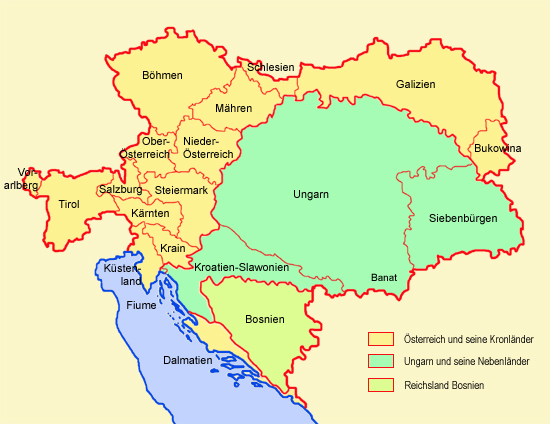
Source: Volker Preuß

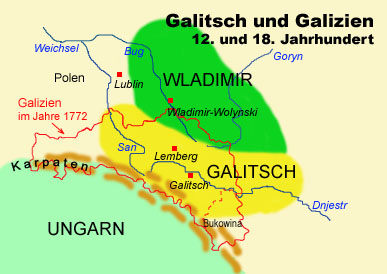
Source: Volker Preuß
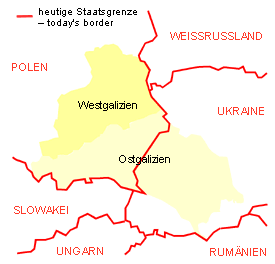
Source: Volker Preuß,
Galicia and it's division into East and West Galicia in the 18th century
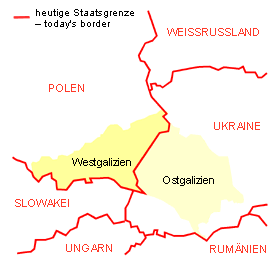
Source: Volker Preuß,
Galicia and it's division into East and West Galicia in the 20th century

Area: 30.310 square miles
Inhabitants: 8.025.700 (1910), thereof 58% Poles, 36% Ruthens (Ukrainians), 5% Jews, 2% Germans
Density of Population: 265 inh./sq.mi. (1910)
Capital: Lemberg (nowadays: Lwow, Lviv), 160.000 inh. (1900), 735.000 inh. (2007)
Languages (to 1918): Polish, Ukrainian, German
Time Zone: in today's West Galicia: MEZ, in today's East Galicia: MEZ + 2 h
Source:
Wikipedia (D)

9th century · evolution of the Wolynian Principality of Vladimir and of a White-Croatian Principality northern the Carpathia Mountains
10th century · conquest by the Rus of Kiev, but later the White-Croatians become dependent from the Polish Grand Prince of Krakau, they leave the country in southern direction, Vladimir becomes independent from the Rus of Kiev
1145 · first mention of the northern the Carpathia Mountains situated Principality of Halych (Galych) named after the capital, under rule of the House of Vladimirovich
1189 · expulsion of the Prince Vladimir of Halych by the Prince Roman of Vladimir
1190 · King Bela III. of Hungary, crowns itself to the "King of Galicia" (Rex Galatiae), his son Andreas becomes proconsul in Galicia
1191 · Prince Vladimir of Halych exiles Andreas the Hungarian proconsul with Polish support
1198 · death of Prince Vladimir of Halych, vanish of the Vladimiroviches, Roman of Vladimir earns the legacy with Polish support
1205 · death of Prince Roman of Vladimir, increasing influence by Poland and Hungary
1215 · Polish-Hungarian conciliation: Daniel (son of Roman) gets Vladimir (Lodomeria), Koloman (2nd son of the Hungarian king) gets Galicia, Koloman becomes crowned to King of Galicia
1220 · conquest of Galicia by the Rus of Novgorod
1228 · Daniel of Lodomeria conquers Galicia
1241 · invasion of the Mongols
1244 · Daniel becomes tributary to the Mongols
1253 · Daniel becomes crowned in Drogitshin by a pontifical legate to "King of Galicia" gekrönt
1266 · death of king Daniel, successor is his son Shwarno, linking of Galicia (and Lodomeria) to Lithuania
1340 · vanish of the House of Roman, the king of Poland (Kasimir III.) earns the legacy in Galicia
1349 · Lithuania appropriates Lodomeria
1370 · death of Kasimir III. king of Poland, Galicia and Lodomeria come to Hungary
1382 · marriage of Hedwig (Princess of Hungary) with the Grand Prince Vladislav Yagiello of Poland-Lithuania, Galicia and Lodomeria come to Poland
1741 · Empress Maria Theresia of Habsburg earns the title "King of Galicia and Lodomeria"
1772 · First Polish Partition, Galicia and Lodomeria (since 1795 named East Galicia) come on the Austrian Habsburgs
1795 · Third Polish Partition, Little Poland (Duchy of Krakau-Sendomir, since 1795 named West Galicia) comes to the Austrian Habsburgs
1797–1809 · French Revolutionar Wars, parts of Austria (Styria) become occupied by the French in 1797
1809 · Austria has to cede West Galicia to the Grand Duchy of Warsaw
1814/1815 · Congress of Vienna, realignment of Europe after the era Napoléon, the Grand Duchy of Warsaw becomes partitioned between Russia and Prussia, the Republic of Krakow (Krakau, Cracow) remains as Polish state
1830 · riots of the Polish
1846 · the Republic of Krakow (Krakau, Cracow) comes as Grand Duchy of Krakau to the Empire of Austria
1848/1849 · revolution in Vienna, Franz Joseph I. of Habsburg becomes new Emperor, new constitution: the titular hereditary territories of the Habsburgs in the Austrian Empire become converted to crown lands with their own Landtag (parliament), the Kingdom of Galicia and Lodomeria becomes in this way a crown land of the Austrian Empire, the Grand Duchy of Krakow (Krakau, Cracow) becomes affiliated to the Crown Land Kingdom of Galicia and Lodomeria
1861 · separation of the Bukovina from Galicia and Lodomeria as an own crown land
1919 · in context with the dissolution of Austria-Hungary Galicia comes to Poland
1939 · Poland gets partitioned between the German Empire and the Soviet Union approximately along the Curzon-Line, therewith Galicia is divided, Western Galicia comes to the German Empire, Eastern Galicia comes to the Soviet Union and is affiliated to the Soviet-Ukraine
Source: Atlas zur Geschichte,
Wikipedia (D),
World Statesmen,
RetroBib Retrobibliothek,
Discovery '97,
Volker Preuß

The name "Galicia" id derived from the word "Halych" respectively "Galych", the former name of the country as a Slavic principality, named after the same named former capital of the principality, placed on Dniester River. Lodomeria is the latinized name of the former Principality of "Vladimir" in Wolhynia. "Vladimir" means translated "Rule the World".
Source:
Wikipedia (D)

Further Austria pages (historical flags and coats of arms):
• Empire of the Austrian Habsburgs (to 1804)
• Empire of Austria (1814–1867)
• Austria-Hungary (1867–1918)
• Republic of Austria (since 1918)

![]()
























